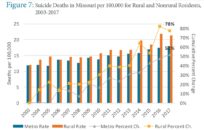In the debate over wildlife management efforts, science continues to triumph over misinformation.
On Dec. 11, the Missouri Conservation Commission greenlighted the Missouri Department of Conservation (MDC)’s plan to allow a highly-regulated, limited black bear hunt next fall. This victory came in wake of a highly-coordinated, online smear campaign by the Humane Society of the United States (HSUS).

HSUS grossly attacked MDC and its partners as proponents of so-called “trophy hunting” and bear cub killers. Adding insult to injury, this group deceived Missourians by floating unsubstantiated claims about management efforts, suggesting the hunt will “decimate nearly all the black bears in the state.” The special interest group conveniently ignored well-documented recovery efforts of the ubiquitous American black bear (Ursus americanus). Nor did they acknowledge the role hunters and similar conservationists have played in their recovery.
The department approved the hunt by a unanimous 4-0 vote. It’ll be limited to southern portions of the state and open only to qualified residents. This is the first hunt of its kind in nearly 80 years.
It’s important to clear the air about the current status of the black bear. By no means, in its current standing, is it an imperiled species. In fact, the opposite is true. The International Union for Conservation of Nature (IUCN) currently lists the black bear as “Least Threatened.”
This decision wasn’t made on a whim. In May, MDC released their Black Bear Management Plan (2020-2030) detailing three achievable goals to ensure successful implementation of management efforts. This came at the culmination of a decade-long study conducted in conjunction with a research lab at Mississippi State University. The study, funded in part by Safari Club International Foundation (SCIF), found 540 to 840 bears currently making up the population — with an annual growth rate of 9 percent.
Hunters are an oft-maligned entity by animal rights groups, despite paying the lion’s share of conservation funding in the U.S. Sixty percent of conservation funding is derived from hunting and fishing revenue from licenses and excise taxes collected on guns, ammunition, bows, and fishing tackle. In fact, hunting is currently experiencing a much-needed revival due to the coronavirus pandemic — with more Americans desiring to escape to the outdoors and to harvest free-range, organic meat.
For Brandon Butler, a Missouri hunter and co-host of the Driftwood Outdoors podcast, the black bear hunt — a “conservation success” in his eyes — falls in line with MDC’s mission statement.
“Today, because of our science-based, well-funded model, animals once extirpated from our lands are returning,” said Butler. “In December of 2020, bull elk were harvested by hunters for the first time in over 150 years. Now we are preparing for a black bear season. Conservation success has brought these animals back to us; now hunting must be used as a conservation measure to ensure their population grows at a healthy and sustainable rate.”
In matters related to bear conservation efforts, reason must continue to prevail. The truth about managed hunts must be conveyed and nuance must be at the center of discussion.

Gabriella Hoffman is an award-winning freelance outdoor writer and host of the “District of Conservation” podcast. Her work has been featured in Field & Stream, Outdoor Life, Sporting Classics Daily, Sporting Classics Magazine, Verily Magazine, and other publications. She lives in Alexandria, Virginia.













